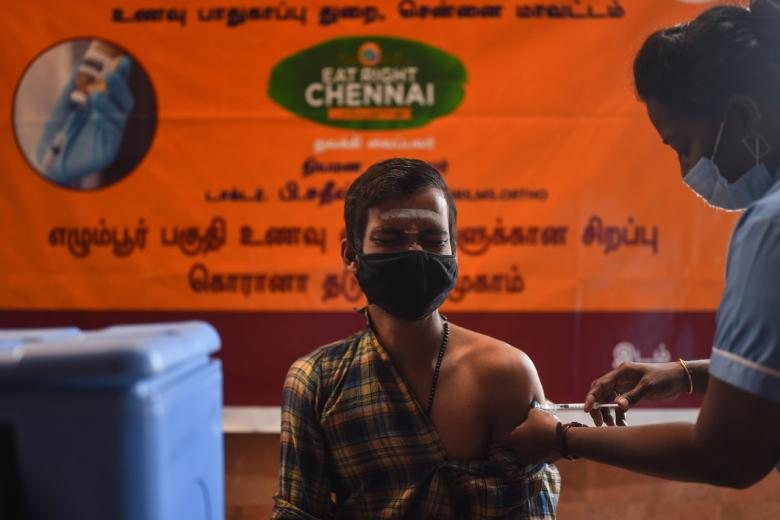NEW DELHI - It was a keenly awaited moment. When India's first billionth Covid-19 vaccine dose was finally administered on Thursday (Oct 21) - a little more than nine months after the country launched its vaccination campaign - the government welcomed it with a big bash.
Monuments were lit up and a special song released to commemorate this milestone. For many in India, which was hit by a second Covid-19 wave that peaked in May as well as a vaccine shortage in July, it was a befitting celebration.
But this euphoria obfuscates the uphill road ahead for the country as it tries to meet the increasingly elusive target of vaccinating 944 million adults by the end of December.
Just around 32 per cent of this population segment are fully vaccinated and another 44 per cent or so have received their first dose. This leaves around a quarter of adults in the country unvaccinated, many of them located in hard-to-reach and far-flung areas.
These statistics exclude those under 18 years old, who make up around 41 per cent of India's 1.3 billion population and are not yet eligible for any Covid-19 jab.
With three dual-dose vaccines in its arsenal, India currently has to administer more than 12.5 million doses daily to complete full adult vaccination by Dec 31. But instead of an accelerated daily vaccination rate, the number has been declining. According to the government dashboard, the seven-day moving average has fallen from a peak of 9.5 million per day between Sept 11 and 17 to 4.2 million between Oct 16 and 22.
It is, however, expected that the pace will pick up in the next few weeks as more people become eligible for their second dose. Covishield, the Indian-made version of the AstraZeneca vaccine that accounts for around 90 per cent of the country's vaccination, has a prescribed gap of 12 weeks between its two doses.
Vaccine supply is no longer a bottleneck - official data as at Oct 21 showed that around 108.5 million doses are currently stocked with India's states and union territories. The vaccination rate may have fallen instead because of reduced demand.
"Perhaps the undecided and the 'vaccine hesitants' are now the ones left and the tapering of numbers could be an outcome of this," noted an analysis published this week by the Observer Research Foundation (ORF), a Delhi-based think-tank.
Another potential sign of falling demand for vaccination is that the number of first doses administered daily has been outstripped by second doses since Oct 13, with the former's proportion on a clear decline over the last six weeks. "This could only mean that the vaccination drive in many parts of the country may have already reached the easy-to-reach population," the analysis said.
Reaching out to the remaining 25 per cent or so of unvaccinated adult Indians will require the campaign to become sharper with additional efforts from the government and civil society, Mr Oommen C. Kurian, the head of ORF's Health Initiative, told The Straits Times.
"You now have to take vaccination to the people," he said. "If you can't bring people to vaccination centres, you will have to convince them to accept it when it reaches their area and the message has to be customised in their language and delivered repeatedly by local people whom they trust,' Mr Oommen added.

With around 16,000 fresh Covid-19 cases being reported each day now - a far cry from the peak of more than 400,000 cases daily in May - some people have become nonchalant about showing up for their second dose. It is estimated that 90 million across the country are long overdue for their second dose.
The central government this week asked states to target districts with low vaccination rates and push people to take their second dose. Professor Narendra Kumar Arora, chairman of the Covid-19 Working Group of the National Technical Advisory Group on Immunisation, told ST the government's vaccination campaign is "fully conversant" with challenges ahead.
"There is a proactive social mobilisation programme of community engagement taking place now at the micro-planning level," he said, referring to ground-level government health workers who are reaching out to individuals yet to receive their first dose as well as those due for their second dose.
An "all-out effort" to reach inaccessible areas, including through drones, has also been going on. "Eagerness and vaccine enthusiasm are very much there, they have not disappeared. We have to sustain that and ensure there is no complacency from the programme side," he added.
The government expects to begin vaccinating children in November, starting with those suffering from chronic diseases. A portfolio of more than four vaccines for children, including ZyCoV-D, the world's first DNA vaccine, are in the pipeline and expected to be approved for use in the next two-three months.
"From the first quarter next year, once adult immunisation is mostly completed, paediatric immunisation will be taken up with the same gusto and intensity as adult immunisation," Dr Arora said.
It is believed that Covid-19 infection-induced antibodies protect from reinfection for up to six months. For a large chunk of Indians infected during the second wave in April-May this year, this natural protective cover could run out in the next month or so.
Underlining the importance of vaccination in this context, an editorial on Oct 21 in Hindustan Times, an Indian newspaper, said: "This means vaccination-induced immunity will soon be the only weapon to prevent a third wave in the country."












